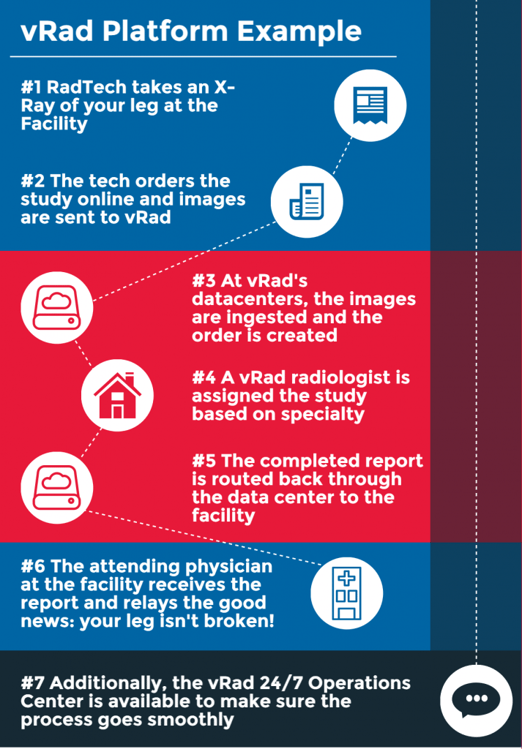The 2nd Key to Unlocking a DevOps Culture: The vRad Development Pipeline
Welcome back to the vRad Technology Quest. At vRad, we value our ability to deliver frequent, regular, and minimally interruptive releases and today...

Remote radiologist jobs with flexible schedules, equitable pay, and the most advanced reading platform. Discover teleradiology at vRad.

Radiologist well-being matters. Explore how vRad takes action to prevent burnout with expert-led, confidential support through our partnership with VITAL WorkLife. Helping radiologists thrive.

Visit the vRad Blog for radiologist experiences at vRad, career resources, and more.

vRad provides radiology residents and fellows free radiology education resources for ABR boards, noon lectures, and CME.

Teleradiology services leader since 2001. See how vRad AI is helping deliver faster, higher-quality care for 50,000+ critical patients each year.

Subspecialist care for the women in your community. 48-hour screenings. 1-hour diagnostics. Comprehensive compliance and inspection support.

vRad’s stroke protocol auto-assigns stroke cases to the top of all available radiologists’ worklists, with requirements to be read next.

vRad’s unique teleradiology workflow for trauma studies delivers consistently fast turnaround times—even during periods of high volume.

vRad’s Operations Center is the central hub that ensures imaging studies and communications are handled efficiently and swiftly.

vRad is delivering faster radiology turnaround times for 40,000+ critical patients annually, using four unique strategies, including AI.
.jpg?width=1024&height=576&name=vRad-High-Quality-Patient-Care-1024x576%20(1).jpg)
vRad is developing and using AI to improve radiology quality assurance and reduce medical malpractice risk.

Now you can power your practice with the same fully integrated technology and support ecosystem we use. The vRad Platform.

Since developing and launching our first model in 2015, vRad has been at the forefront of AI in radiology.

Since 2010, vRad Radiology Education has provided high-quality radiology CME. Open to all radiologists, these 15-minute online modules are a convenient way to stay up to date on practical radiology topics.

Join vRad’s annual spring CME conference featuring top speakers and practical radiology topics.

vRad provides radiology residents and fellows free radiology education resources for ABR boards, noon lectures, and CME.

Academically oriented radiologists love practicing at vRad too. Check out the research published by vRad radiologists and team members.

Learn how vRad revolutionized radiology and has been at the forefront of innovation since 2001.

%20(2).jpg?width=1008&height=755&name=Copy%20of%20Mega%20Nav%20Images%202025%20(1008%20x%20755%20px)%20(2).jpg)

Visit the vRad blog for radiologist experiences at vRad, career resources, and more.


Explore our practice’s reading platform, breast imaging program, AI, and more. Plus, hear from vRad radiologists about what it’s like to practice at vRad.

Ready to be part of something meaningful? Explore team member careers at vRad.
3 min read
 Brian (Bobby) Baker
:
February 9, 2017
Brian (Bobby) Baker
:
February 9, 2017

At vRad, we have a passion for connecting – with each other, with clients, and with patients. In technology, we strive to break down the language barrier between geek-speak and common users to share our tools and processes.
Go ahead, chuckle a little. You have probably found yourself in a meeting with an engineer or a systems administrator listening intently with the best of intentions to what sounded like English but didn’t make any sense.
In an effort to connect more directly, we are embarking on a quest to share how we maintain and enhance the vRad Radiology platform. We’re going to start by sharing an overview and then cover topics ranging from how we manage projects to how we manage downtime; and if you are interested in the nerdy side of things, we’ll cover that too.
vRad is a technology-enabled practice, and the vRad platform is the foundation on which our teleradiology and radiology service capabilities are built.
 |
Teleradiology is the function of radiology imaging interpretation – such as x-rays, MRIs, CTs, etc. – by transmitting images through the cloud to an off-site radiologist. |
To give you an idea of the scope of vRad's platform, it:
We like to refer to platform maintenance as changing the oil on a moving car. Since we never stop serving patients the car can never stop moving either – and agile development helps support that reality.
vRad’s platform consists of three major areas:
 |
A Radiology Information System (RIS) is a radiology-specific electronic health records system that is utilized to track, manipulate and distributed patient images. |
 |
A Picture Archiving and Communications System (PACS) is the software and hardware used for ingesting, storing and viewing medical images (such as x-rays, MRIs, CTs, etc.). |
Utilizing our platform, vRad provides radiology services to hospitals across the country through our network of radiologists also spread across the country.
Let’s say that you are skiing Saturday night and you take that double black diamond a little too fast, have a nasty fall – it wasn’t your fault, the hill was really icy. You might end up in the emergency room - you are cold, wet, and your leg really hurts. The ER physician asks to have an X-Ray performed on your leg.
As your wheelchair gets rolled into the X-Ray room, the radiology technologist does not have to concern himself with calling the on-call Radiologist and waking her up – that’s because their local radiologist practice uses vRad to provide nighttime and weekend coverage, so they have a radiologist on hand 24 hours a day, 7 days a week.
Let’s take a look at what happens next:

This all happens in about 20 minutes, alongside 20,000 other orders being read.
The technology platform that runs all this is developed primarily in-house at vRad headquarters. We have a team of about 35 that analyzes, develops, maintains, tests, and manages the platform and we deploy major updates monthly to bring new features to our clients. The RIS part of the platform manages the orders, workflow, and report distribution. The PACS is responsible for ingesting, storing, and viewing images. And our Biz applications make sure the business surrounding getting radiologists licensed, credentialed, and scheduled goes smoothly.
Over the next few months, we’ll share with you the following topics, lending insight into how our engineering team manages the largest teleradiology platform in the world.
How We Manage Our Projects
vRad Agile (#1): An in-depth look into our agile methodology at vRad
How We Build Our Code
vRad Development Pipeline (#2): Our development pipeline from check-in to production deployment
vRad Test Environments (#3): Managing 30+ environments for continuous testing, user testing, and platform demonstrations
vRad Automated Testing (#4): vRad enables our development efficiency by relying heavily on automated testing – learn a bit about our different types of automated tests.
vRad’s Build Tools (#5): A look at the nerdy internals of the system that helps vRad manage our codebase and environments
How We Do Maintenance and Security
vRad Software Security (#6): How We Ensure Security for vRad’s Clinical Platform
vRad Maintenance Window (#7): An example of our approach to limiting impact of technology maintenance
Until our next adventure,
Brian (Bobby) Baker

Welcome back to the vRad Technology Quest. At vRad, we value our ability to deliver frequent, regular, and minimally interruptive releases and today...

Welcome back to the vRad Technology Quest. Today we’ll cover our development approach to maintaining vRad’s radiology platform. At vRad, our...

Welcome back to the vRad Technology Quest Series. We’ve shared how vRad builds and deploys code (vRad Development Pipeline (#2)). This article is an...
vRad (Virtual Radiologic) is a national radiology practice combining clinical excellence with cutting-edge technology development. Each year, we bring exceptional radiology care to millions of patients and empower healthcare providers with technology-driven solutions.
Non-Clinical Inquiries (Total Free):
800.737.0610
Outside U.S.:
011.1.952.595.1111
3600 Minnesota Drive, Suite 800
Edina, MN 55435